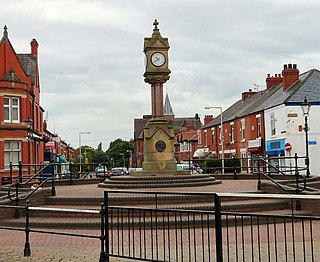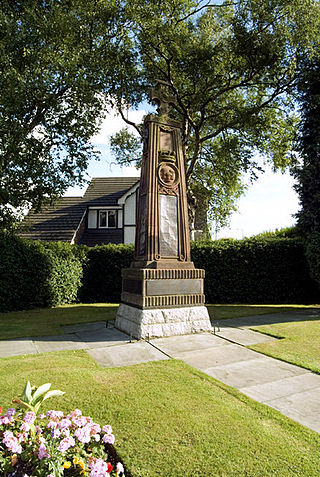Related Research Articles

Stockport is a town in Greater Manchester, England, 8 miles (13 km) south-east of Manchester, 9 miles (14 km) south-west of Ashton-under-Lyne and 12 miles (19 km) north of Macclesfield. The Rivers Goyt and Tame merge to create the River Mersey here. It is the main settlement of the wider Metropolitan Borough of Stockport.

Reddish is an area in Metropolitan Borough of Stockport, Greater Manchester, England. 4.6 miles (7.4 km) south-east of Manchester city centre. At the 2011 census, the population was 28,052. Historically part of Lancashire, Reddish grew rapidly in the Industrial Revolution and still retains landmarks from that period, such as Houldsworth Mill, a former textile mill.

A Sunday school, sometimes known as a Sabbath school, is an educational institution, usually Christian in character and intended for children or neophytes.

Cheadle Hulme is a suburb in the Metropolitan Borough of Stockport, Greater Manchester, England,. Historically in Cheshire, it is 2 miles (3.2 km) south-west of Stockport and 8 miles (12.9 km) south-east of Manchester. It lies in the Ladybrook Valley, on the Cheshire Plain, and the drift consists mostly of boulder clay, sands and gravels. In 2011, it had a population of 26,479.

The Cheshire Lines Committee (CLC) was formed in the 1860s and became the second-largest joint railway in Great Britain. The committee, which was often styled the Cheshire Lines Railway, operated 143 miles (230 km) of track in the then counties of Lancashire and Cheshire. The railway did not become part of the Big Four during the implementation of the 1923 grouping, surviving independently with its own management until the railways were nationalised at the beginning of 1948. The railway served Liverpool, Manchester, Stockport, Warrington, Widnes, Northwich, Winsford, Knutsford, Chester and Southport with connections to many other railways.
Heaton Norris is a suburb of the Metropolitan Borough of Stockport, Greater Manchester, England. It is one of the Four Heatons, along with neighbours Heaton Chapel, Heaton Mersey and Heaton Moor. Originally within the boundaries of the historic county of Lancashire, part of Heaton Norris was annexed to the County Borough of Stockport in 1835; Heaton Chapel and Heaton Moor followed in 1894 and the remnant in 1913.
Heaton Chapel is an area in the northern part of Stockport, Greater Manchester, England. Within the boundaries of the historic county of Lancashire, it borders the Manchester districts of Levenshulme to the north, the Stockport districts of Heaton Moor to the west, Reddish and Heaton Norris to the east, and Heaton Mersey to the west and south. Heaton Chapel and its neighbouring areas are known collectively as the Four Heatons.

Ragged schools were charitable organisations dedicated to the free education of destitute children in 19th-century Britain. The schools were developed in working-class districts and intended for society's most impoverished youngsters who, it was argued, were often excluded from Sunday School education because of their unkempt appearance and often challenging behaviour. After a few such schools were set up in the early 19th century by individual reformers, the London Ragged School Union was established in April 1844 to combine resources in the city, providing free education, food, clothing, lodging, and other home missionary services for poor children. Although the Union did not extend beyond London, its publications and pamphlets helped spread ragged school ideals across the country before they were phased out by the final decades of the 19th century.

Heaton Moor is a suburb of Stockport, Greater Manchester, England. It is one of the Four Heatons and borders Heaton Chapel, Heaton Norris and Heaton Mersey. Heaton Moor has Victorian housing, built between 1852 and 1892, along affluent tree-lined streets which follow the field patterns of a former agricultural economy.

Industrial schools were intended to solve problems of juvenile vagrancy in England by removing poor and neglected children from their home environment to a boarding school. The Industrial Schools Act 1857 allowed magistrates to send disorderly children to a residential industrial school. An 1876 act led to nonresidential day schools of a similar kind.
A reformatory or reformatory school is a youth detention center or an adult correctional facility popular during the late 19th and early 20th centuries in Western countries. In the United Kingdom and United States, they came out of social concerns about cities, poverty, immigration, and gender following industrialization, as well as from a shift in penology to reforming instead of punishing the criminal. They were traditionally single-sex institutions that relied on education, vocational training, and removal from the city. Although their use declined throughout the 20th century, their impact can be seen in practices like the United States' continued implementation of parole and the indeterminate sentence.

Bredbury is a town in the Metropolitan Borough of Stockport, Greater Manchester, England. It is located 8 miles (12.9 km) south-east of Manchester, 2 miles (3.2 km) east of Stockport and 3 miles (4.8 km) south-west of Hyde. At the 2011 census, it had a population of 16,721.

The Sheffield and Midland Railway Companies' Committee was incorporated by the Manchester, Sheffield and Lincolnshire Railway and Midland Railway Companies Act 1869 as a joint venture between the Midland Railway and the Manchester, Sheffield and Lincolnshire Railway.

Stockport County Borough was a county-level local authority between 1889 and 1974.

St George's Church is in Buxton Road, Heaviley, an area of Stockport, Greater Manchester, England. It is an active Anglican parish church in the deanery of Stockport, the archdeaconry of Macclesfield, and the diocese of Chester. Its benefice is united with that of St Gabriel, Adswood. The church is recorded in the National Heritage List for England as a designated Grade I listed building. The authors of the Buildings of England series express the opinion that it is "by far the grandest church of Stockport", and state "St George is a church on a splendid scale". According to the visitors' guide to the church, the Rt Revd Geoffrey Fisher, former archbishop of Canterbury, said that it is "the finest church built in England since the Reformation".

School uniforms in England are worn in over 90% of primary and secondary schools in England. Parents are required to purchase the uniform which in 2015 averaged roughly £212.88 per child.

Macclesfield Sunday School is in Roe Street, Macclesfield, Cheshire, England. It started in 1796 as a non-denominational Sunday School in Pickford Street, which catered for 40 children. It was founded by John Whitaker whose objective was "to lessen the sum of human wretchedness by diffusing religious knowledge and useful learning among the lower classes of society". Though chapels set up their denominational schools, the Sunday School committee in 1812 elected to erect a purpose-built school on Roe Street. The Big Sunday School had 1,127 boys and 1,324 girls on its books when it opened. The building is now known as The Old Sunday School and is part of Macclesfield Museums.

Stockport School is a mixed 11–16 secondary school in Stockport, Greater Manchester, England.

Stockport Georgians Association Football Club is a football club based in Stockport, England. They are currently members of the North West Counties League Division One South and play at Cromley Road, Stockport.

Joseph Hughes (1769–1833) was an English Baptist minister, best known for his role as a founder of the British and Foreign Bible Society.
References
- ↑ "Stockport Archives Cache".[ dead link ]
- 1 2 "The Modern Sunday school". [London] : Sunday School Union. 22 August 1887 – via Internet Archive.
- ↑ Samuel Oldknow and the Arkwrights: the Industrial Revolution at Stockport p40 To put it in historical context John Wesley had visited Stockport on 12 June 1784:
- 1 2 3 Watson, William Henry (22 August 1862). "The first fifty years of the Sunday school". London : Sunday School Union – via Internet Archive.
- ↑ "St Thomas Church, Heaton Chapel". stephen.shawweb.co.uk.
- ↑ http://www.oldtowns.co.uk/Cheshire/stockport.htm Scan from a directory
- ↑ Hansard
- ↑ https://wiki.familysearch.org/en/England_Schools Family search
- ↑ "A CHILD MURDERED BY CHILDREN" . The Independent. 23 April 1995. Archived from the original on 25 May 2022.